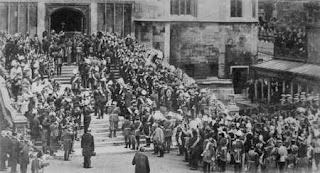King Edward VII’s funeral, which took place on Friday 20 May 1910, was a one of the 20th Century’s first ‘global events’. Royalty from all over Europe (for a full list of the funeral’s royal attendees, click here) attended the event, in what would be one of the final flourishes of the European monarchical system before it was devoured by the cataclysmic events of the First World War.
It is also important to remember the global reach of the British Empire in 1910 (see map below for the territories (they are coloured in red on the map) the Empire contained in 1910). When King Edward VII died he was not only the King of England and the British Dominions, he was also the Emperor of India. The news of his death would have therefore been global news, and we must speculate whether this footage from his funeral would have made its way to the various corners of the globe.
The first impression I gathered from watching this brief film was just how much information there is on screen to digest. Even in the lavish production of early Italian films such La Presa Di Roma (1905) and Nerone (1909), a fiction film had not come close to portraying the sheer number of (mostly military) people who are visible throughout this film. As the screen becomes populated almost exclusively by military figures, I could not help but shudder at this unintentional cinematic prophesy of the forthcoming century.
The lavish opulence of the ceremony interweaves with its militaristic uniformity. Whereas the contemporary audience would have been immersed in national mourning, I could not help thinking of the forthcoming war – the relentless march of the various military men reminded of the historian A.J.P. Taylor’s ‘timetable theory’:
In his 1969 book War by Timetable, Taylor examined the origins of World War I. He concluded that though all of the great powers wished to increase their own power relative to the others, none consciously sought war before 1914. Instead, he argued that all of the great powers believed that if they possessed the ability to mobilise their armed forces faster than any of the others, this would serve as a sufficient deterrent to avoid war and allow them to achieve their foreign policy. Thus, the general staffs of the great powers developed elaborate timetables to mobilise faster than any of their rivals. When the crisis broke in 1914, though none of the statesmen of Europe wanted a world war, the need to mobilise faster than potential rivals created an inexorable movement towards war. Thus Taylor claimed that the leaders of 1914 became prisoners of the logic of the mobilisation timetables and the timetables that were meant to serve as deterrent to war instead relentlessly brought war.
In my over imaginative mind, as the troops march off screen they are walking towards the trenches of the Somme and Champagne.




















A very interesting actuality - it appears to foreshadow the visual style and tone of recordings of royal occasions through the TV era and to today. I'm really interested in the audio. It sounds like a phonograph recording but I wonder if it was recorded specifically for the film itself or a separate recording added for this video. Even though we're firmly in the silent period there were some movies that used sound recording in a variety of ways.
ReplyDelete@Christian Hayes - Thank you for sharing your knowledge about the audio recording. I was actually confused as to when it might be from, so I refrained from commenting on it. It would helpful knowing if the recording was intended for that specific part of the footage.
ReplyDeleteAnd I would like to learn more about how sound recordings were used in this era when they were set against such footage.